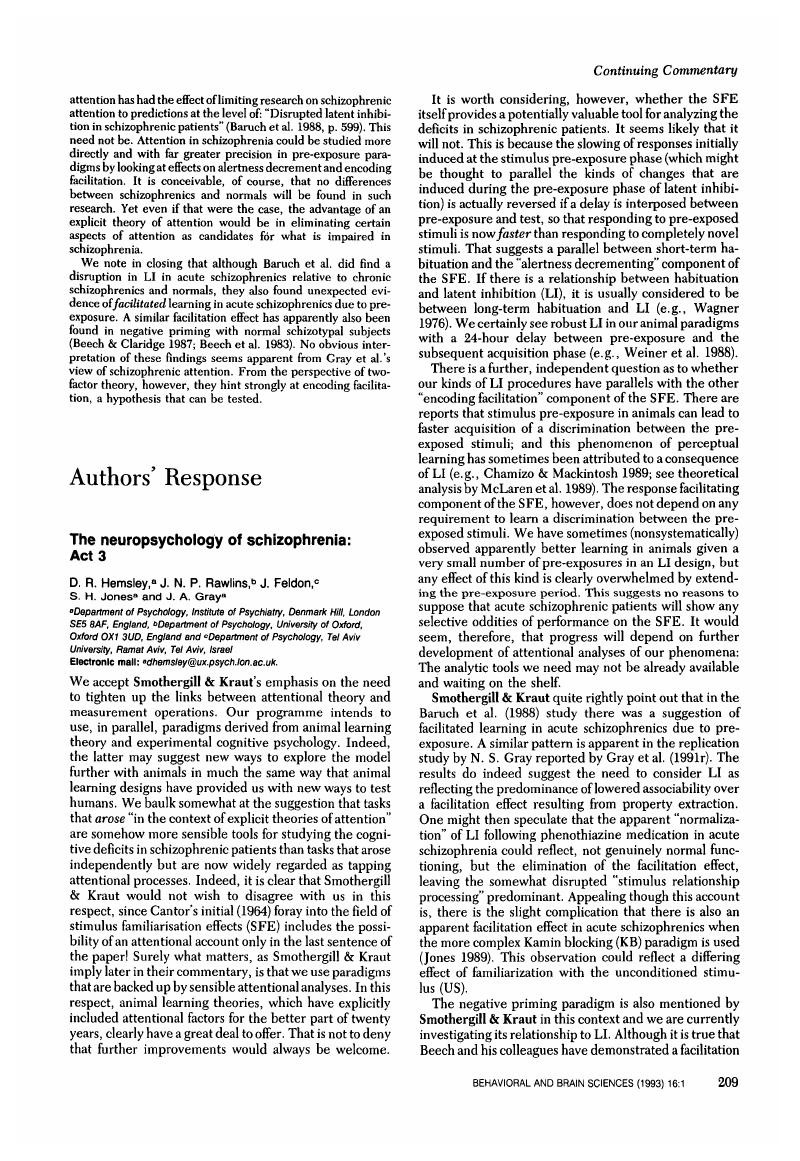Crossref Citations
This article has been cited by the following publications. This list is generated based on data provided by Crossref.
Hemsley, David R.
1993.
A simple (or simplistic?) cognitive model for schizophrenia.
Behaviour Research and Therapy,
Vol. 31,
Issue. 7,
p.
633.
Hemsley, David R.
1994.
A cognitive model for schizophrenia and its possible neural basis.
Acta Psychiatrica Scandinavica,
Vol. 90,
Issue. s384,
p.
80.
Hemsley, David R.
1996.
Schizophrenia.
Behavior Modification,
Vol. 20,
Issue. 2,
p.
139.
Pflieger, Mark E.
2003.
Inferring contextual field interactions from scalp EEG.
Behavioral and Brain Sciences,
Vol. 26,
Issue. 1,
p.
99.
Ginsberg, J. P.
2003.
Setting domain boundaries for convergence of biological and psychological perspectives on cognitive coordination in schizophrenia.
Behavioral and Brain Sciences,
Vol. 26,
Issue. 1,
p.
88.
Kisley, Michael A.
and
Davalos, Deana B.
2003.
Is sensory gating a form of cognitive coordination?.
Behavioral and Brain Sciences,
Vol. 26,
Issue. 1,
p.
94.
Strelets, Valeria
2003.
Cortical connectivity in high-frequency beta-rhythm in schizophrenics with positive and negative symptoms.
Behavioral and Brain Sciences,
Vol. 26,
Issue. 1,
p.
105.
Barendregt, Hendrik Pieter
2003.
A wide-spectrum coordination model of schizophrenia.
Behavioral and Brain Sciences,
Vol. 26,
Issue. 1,
p.
84.
Oades, Robert D.
Röpcke, Bernd
and
Oknina, Ljubov
2003.
Context, connection, and coordination: The need to switch.
Behavioral and Brain Sciences,
Vol. 26,
Issue. 1,
p.
97.
Barch, Deanna M.
and
Braver, Todd S.
2003.
Where the rubber meets the road: The importance of implementation.
Behavioral and Brain Sciences,
Vol. 26,
Issue. 1,
p.
83.
MacDonald, Angus W.
2003.
Reconciling schizophrenic deficits in top-down and bottom-up processes: Not yet.
Behavioral and Brain Sciences,
Vol. 26,
Issue. 1,
p.
96.
Chen, Yue
2003.
Spatial integration in perception and cognition: An empirical approach to the pathophysiology of schizophrenia.
Behavioral and Brain Sciences,
Vol. 26,
Issue. 1,
p.
86.
Bressler, Steven L.
2003.
Context rules.
Behavioral and Brain Sciences,
Vol. 26,
Issue. 1,
p.
85.
Sass, Louis A.
and
Uhlhaas, Peter J.
2003.
Phenomenology, context, and self-experience in schizophrenia.
Behavioral and Brain Sciences,
Vol. 26,
Issue. 1,
p.
104.
Hemsley, David R.
2003.
Schizophrenic cognition: Taken out of context?.
Behavioral and Brain Sciences,
Vol. 26,
Issue. 1,
p.
91.
Williams, Leanne M.
Lee, Kwang-Hyuk
Haig, Albert
and
Gordon, Evian
2003.
High-frequency synchronisation in schizophrenia: Too much or too little?.
Behavioral and Brain Sciences,
Vol. 26,
Issue. 1,
p.
109.
Talamini, L. M.
Meeter, M.
and
Murre, J. M. J.
2003.
Combating fuzziness with computational modeling.
Behavioral and Brain Sciences,
Vol. 26,
Issue. 1,
p.
107.
Silverstein, Steven M.
and
Phillips, William A.
2003.
Cognitive coordination and its neurobiological bases: A new continent to explore.
Behavioral and Brain Sciences,
Vol. 26,
Issue. 1,
p.
110.
Condray, Ruth
and
Steinhauer, Stuart R.
2003.
Mechanisms of disrupted language comprehension in schizophrenia.
Behavioral and Brain Sciences,
Vol. 26,
Issue. 1,
p.
87.
Raffone, Antonino
Murre, Jaap M. J.
and
Wolters, Gezinus
2003.
NMDA synapses can bias competition between object representations and mediate attentional selection.
Behavioral and Brain Sciences,
Vol. 26,
Issue. 1,
p.
100.





